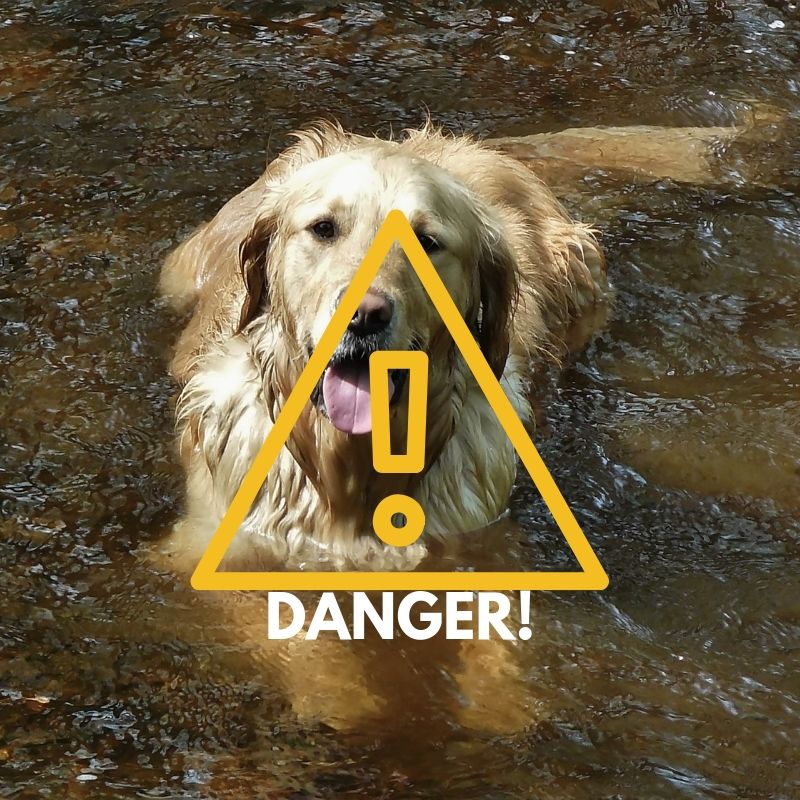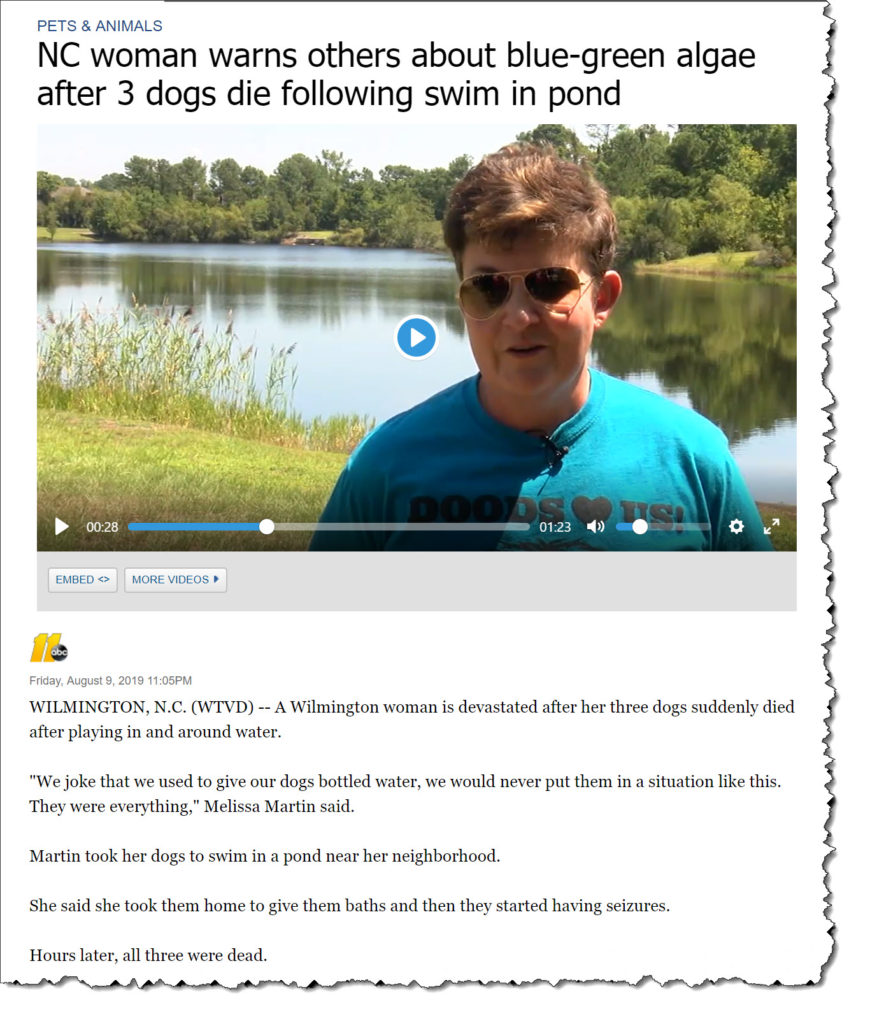Don’t Take Your Dog Swimming Until You Read This Warning!
With the recent reports of dogs tragically dying within mere hours of swimming in lakes and ponds infected with Blue-Green Algae, it is time for everyone to become proactive in protecting our pet’s health. The key factor in this fight is education, we must know and understand the deadly Blue-Green Algae which has turned a fun day in the water, to tragedy.
In recent weeks many pet owners have taken to the water with their pets for a fun, lazy summer day, however, by nightfall, the fun day in the water turned deadly for many pets.
But what is this alga, where do you find it, what can you do to prevent exposure, and what are the actions to take if you think your dog has been exposed? All these concerns and more will be examined as we search to find a way to keep our precious dogs safe in the heat of the summer.
It is imperative that we not only protect our dogs but educate ourselves and fellow dog owners, so we can save them too!
Don’t Take Your Dog Swimming Until You Read This Warning!

What is Blue-Green Algae?
What is Blue-Green Algae? Blue-Green Algae is a group of organisms that mimic the appearance of algae by clumping together in bodies of water. The actual term Blue-Green Algae refers to a group of bacteria known as cyanobacteria, which is often not visible by the naked eye, unless they clump together, appearing as greenish bundles or brown spots in a pond, lake, or stream.
The algae will bloom on the surface of the water resembling pea soup. The coloring is derived from the chlorophyll resembling plants. The algae can have a pungent or musty smell, however, not all blooms give off an odor.
Unfortunately, the toxins can remain in the water after the bloom has dissipated making it a silent threat, especially when the cells do not clump together making the ability to see them with the naked eye impossible.
Where Does Blue-Green Algae Come From?
Where Does Blue-Green Algae Come From? The origin of Blue-Green Algae is usually in warm, nutrient-rich (high phosphorus and nitrogen) environments. The rapidly growing algae creates blooms that spread across the waters surface. The blooms are often caused by agricultural and stormwater runoff, as well as, leaking from septic systems. Experts have warned the use of fertilizer runoff in warm water temperatures can be a large contributor to the increase in Blue-Green Algae.
Blue-green algae block the sunlight required for other organisms to live by depleting the oxygen and nutrients they need to survive. You cannot tell by visual inspection if a bloom has toxins in it. It is better to be safe with your pets and yourself, if you have doubts, don’t swim!
Why is Blue-Green Algae Toxic for Dogs?
Why is Blue-Green Algae Toxic for Dogs? Blue-Green Algae has proven extremely toxic for dogs as it concentrates on the dog’s liver functions. Sadly, dogs that have been exposed to the toxic algae, often die, if the dogs do live, they will likely face long term health problems.
Experts stress the actual amount of toxins ingested does not have to be very much to cause the liver to go into sudden failure, sometimes within hours, but certainly within a day or two.
Common Warning Signs of Toxic Blue-Green Algae Exposure
If your dog exhibits any of the following symptoms you are advised to contact your veterinarian immediately (or take your dog immediately for medical attention):
- Vomiting
- Diarrhea
- Seizures/fits
- Weakness/collapses/unconsciousness
- Disorientation or confusion
- Drooling
- Breathing difficulties
- Coma
- Shock
- Neurologic signs (including muscle tremors, muscle rigidity, paralysis)
- Excessive secretions (salivation, lacrimation)
Where Does Blue-Green Algae Grow?
Where Does Blue-Green Algae Grow? (States – Locations) The growth of Blue-Green Algae is most common in non-flowing fresh water such as lakes and ponds, during warmer weather and little rainfall.
The following areas have been reported as having the blue-green algae in bodies of water.
- Austin, Texas has been reported as the first location of dog deaths this summer (Lady Bird Lake).
- Three dogs died in Wilmington, North Carolina.
- A dog was reported having died after swimming in lake in Georgia.
- A dog in Maine started have seizures after swimming in a local pond.
The growth of the deadly algae has been spreading as the levels have been found in New York, Vermont, Rhode Island, Wisconsin, Oregon, Kansas, California, Florida, Texas, Indiana and Minnesota.
Not All Algae is Toxic
Experts stress not all dark green algae is toxic, such as seen at beaches referred to as Cladophora, this alga often stays at the bottom of a pond or lake, only rising to the surface by waves.
What Months Have the Most Blue-Green Algae Growth?
What Months Have the Most Blue-Green Algae Growth? The Summer months seem to be when the Blue-Green Algae has the largest recorded growth, coupled with a reduction in rain fall. Additionally, you can find the algae growing in the early fall if they have the nutrients required for survival.
The development and production of algal blooms likely result from a combination of environmental factors including available nutrients, temperature, sunlight, ecosystem disturbance, hydrology (river flow and water storage levels) and the water chemistry.
Can You Remove Blue-Green Algae From Water?
Can You Remove Blue-Green Algae From Water? Attempting to remove the Blue-Green Algae from the water is not foolproof. Treatment of a surface water that is experiencing a blue-green algae bloom with an herbicide or algaecide may kill the algae, but any toxins contained in the cells will be released at once, resulting in a slug of toxins in the water.
What Should I Do If I Think My Dog Has Been Exposed to Blue-Green Algae?
What Should I Do If I Think My Dog Has Been Exposed to Blue-Green Algae? If your dog has been exposed to Blue-Green Algae you need to act immediately by taking your dog directly to the nearest ER.
Your veterinarian or local ER can perform blood work designed to measure liver enzymes, blood sugar levels, low protein and abnormal clotting.
It cannot be stressed enough the importance of seeking immediate medical attention if you believe your pet has been exposed.
How Do I Protect My Dog?
How Do I Protect My Dog? The best course of action for your dog is prevention by knowing what you can do to help protect your dog from exposure. You should keep abreast of water conditions in your area or if you are traveling with your pets. It is best to avoid bodies of water that are cloudy, have green algae near the surface, or floating particles.
Regulatory agencies are working with their local communities to reduce stormwater runoff and encourage agricultural practices that reduce soil erosion (which has been found to be a large contributor to the nutrients needed for algae growth).
The public can help reduce nutrient concentrations by promoting the following practices in their communities:
- Use lawn fertilizers only where truly needed
- Prevent yard debris (leaves, grass clippings) from washing into storm drains.
- Support local ordinances that require silt curtains for residential and commercial construction sites.
- Plant and maintain vegetative buffer strips along shorelines of lakes, ponds and streams.
Can Toxic Shock from Blue-Green Algae Be Treated In Dogs?
Can Toxic Shock from Blue-Green Algae Be Treated In Dogs? Toxic shock can be treated by a veterinarian; however, it is important to note the survival rate for dogs exposed to Blue-Green Algae is low.
Treatment includes anti-seizure medication, oxygen, and aggressive care by your veterinarian. Currently, there is not an antidote for the toxins produced by blue-green algae, but immediate veterinary care is imperative.
What is the best way to prevent my pet from being exposed to Blue-Green Algae?
What is the best way to prevent my pet from being exposed to Blue-Green Algae? The best way to prevent your dog from becoming exposed to the algae is education and common sense.
Pay attention to the water’s appearance, you should never swim, or boat in water that is discolored or if there is the presence of scum, foam, or mats of algae on the surface. You should never allow your children and pets to drink or play in questionable water.
It is important to rinse off with fresh water as soon as possible after exposure to the Blue-Green Algae, your dogs should be rinsed immediately to prevent the licking of their fur and exposing themselves to the toxins.
Local public health authorities are great resources for keeping abreast of water-body closures or infested waters. Additionally, experts recommend you should ALWAYS pay close attention to, and heed, any warning signs posted at beaches or other bodies of water.
In Conclusion
No matter how hard we try to keep our pets safe and sound, potentially dangerous occurrences can happen that are beyond our control.
It is important as pet owners to heed the warnings from professionals when health epidemics arise. We MUST act quickly in order to ensure the safety of our pets.
Be aware of warnings from the Environmental Agency and CDC, if there are risks the public should be informed of, these sources are a great start. Learn what the algae is, the forms it can take and what you should do if you feel your dog has been exposed.
Many owners who have
Carefully examine the area around the water, as well as, the body of water for any contamination. It only takes a few minutes to preserve a lifetime of precious memories with your best friend. They depend on us to protect them and keep them safe too!
